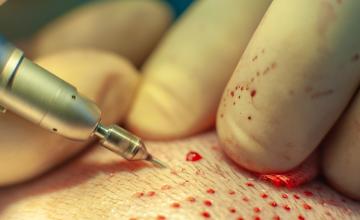FUE – a new way of doing Follicular Unit Hair Transplantation

Follicular unit extraction is a minimally invasive procedure for performing follicular unit hair transplantation. However, unlike the predominant follicular unit transplant procedure, in which a strip of donor tissue is removed and dissected under magnification, the FUE procedure uses a small punch to extract each follicular unit one by one.
Both the strip excision and FUE procedures create 1, 2, 3, and 4 hair follicular unit grafts that are then transplanted into the balding area in the same manner. The primary difference between these two procedures is the technique used to harvest the follicular unit grafts.
Comparing the Strip Excision procedure to the Extraction (FUE) procedure
The common strip excision method of performing follicular unit hair transplantation involves surgically excising a thin horizontal strip of bald resistant skin from the donor area.
Strip Excision Procedure



This donor area is then sutured together. These sutures (either stitches or staples) are then typically removed about ten days after surgery. Some physicians use dissolvable sutures so that no removal is needed.

Once this linear incision is fully healed the patient is left with a thin horizontal scar in the back of the head. This scar is typically hard to detect since the surrounding hair conceals it, even when the hair is cut short.
To view a video of an actual strip excision surgery.
How the FUE Procedure is performed
With the Follicular Unit Extraction or FUE procedure 1, 2, 3, and 4 hair follicular unit grafts are carefully extracted one at a time using a tiny punch of one millimeter or less. Often the surgeon requires the patient to buzz cut a portion of their donor area so that they are able to see the patient’s scalp.

The follicular units are extracted by placing the punch around a single follicular unit and cutting a small circle through the skin around that follicular unit. The follicular unit is then gently pulled up and away from the loose tissue underneath the skin.
The small hole left behind after the follicle is extracted then heals over the following week. Normally this small round incision contracts as it heals making the resulting round scar smaller than the size of the 1mm punch that made the incision. The FUE patient ultimately ends up with hundreds of small round white scars, which are normally not detectable once the patient’s hair grows out.View a video of an actual FUE surgery.
To Extract or to Excise, that is the question.
Advocates for the relatively new FUE procedure claim that this procedure produces less noticeable scarring and no tightness or numbness in the donor area since no donor tissue has been pulled together and sutured. Many patients and physicians find the claim that FUE produces less visible scarring to be debatable.
Some physicians and patients also have concerns about the relatively new FUE procedure, such as the lack of formal studies regarding the percentage of follicles that may or may not be transected during the sight unseen extraction process.
In addition, since the physician must personally extract all follicles, one by one, the FUE procedure is very physician dependent and thus very expensive. The FUE procedure also requires considerably more time in surgery to move a given amount of hair to the balding area.
The standard strip excision procedure has the advantage of utilizing a collaborative team to carefully create the grafts once the donor tissue is removed in a strip. This collaborative approach enables a well trained staff to do sessions of 2,000 to 3,000 all follicular unit grafts in a single day. This team approach enables a patient to get a much larger number of grafts/hairs in one sitting at a much lower cost per hair than with the FUE procedure.
However, some believe that despite being relatively costly the FUE procedure may be appropriate for patients who have very limited elasticity in their donor area or who only need a small number of grafts.


















